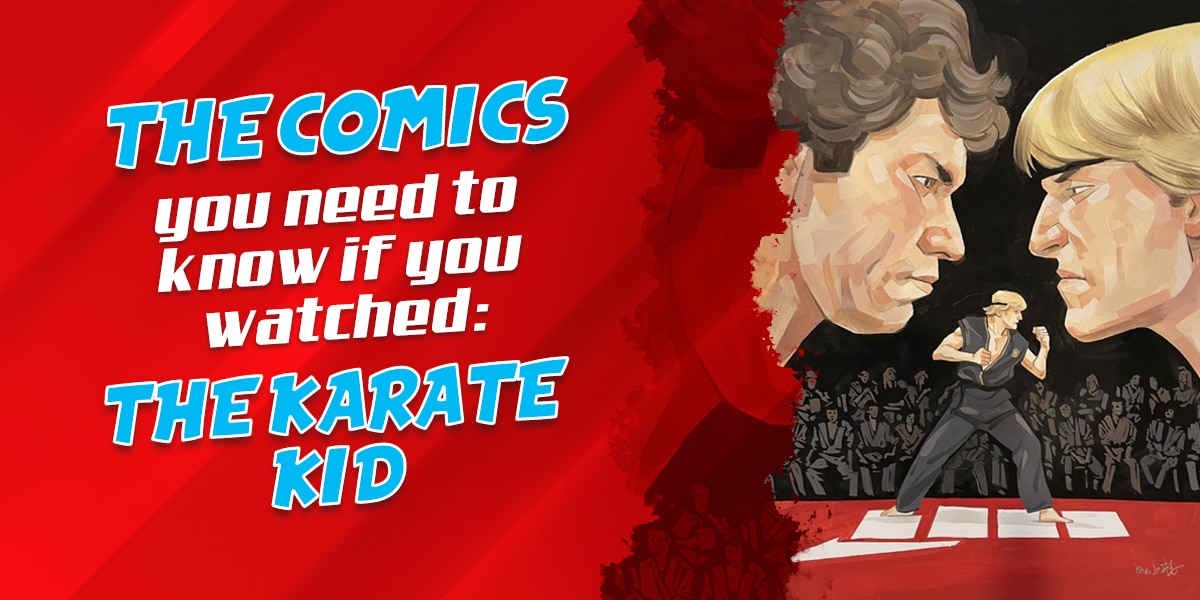The Comics You Need to Know if You’ve Seen The Karate Kid
Have you ever wondered if the world of Karate Kid extends beyond the movies and series we know? Get ready for a surprising revelation: the universe of martial arts and teenage heroes has much deeper roots in the comic book world than you might imagine. If you’re a fan of the Karate Kid saga and Cobra Kai, you’re about to discover a hidden treasure trove of stories that will broaden your perspective and make you see these iconic characters in a new light.
In this fascinating journey, we’ll explore comics that not only complement the narrative you know but also offer unexpected twists and alternative perspectives that will leave you speechless. From futuristic superheroes to reinterpretations of the classic story, these comics will immerse you in a world where karate mixes with science fiction, action, and teenage drama in ways you never imagined.
So adjust your belt, adopt the crane stance, and get ready for a journey through time and space in the expanded universe of Karate Kid. Wax on, wax off, and let’s begin this exciting adventure!
The Historical Importance of Karate Kid
Karate Kid has left an indelible mark on popular culture that transcends generations. Since its debut in 1984, the story of Daniel LaRusso and his mentor, Mr. Miyagi, has inspired millions of people worldwide. The iconic “crane kick” with which Daniel defeats Johnny Lawrence in the final tournament has become a symbol of overcoming and determination.
But the influence of Karate Kid goes far beyond a simple 80s movie. It has evolved into a multi-generational franchise with the Cobra Kai series, which not only revives nostalgia for original fans but also captivates a new generation of viewers. This longevity demonstrates the enduring power of its universal themes: personal growth, the importance of the mentor-apprentice relationship, and the fight against bullying.
What many don’t know is that Karate Kid’s legacy in the comic book world is equally rich and fascinating. These comics not only complement the narrative we know from movies and series but also expand the universe in surprising and unexpected ways. Want to explore more about how these fascinating universes are created? Discover here how to bring your own stories to life.

The Original Karate Kid: A DC Superhero
Prepare for a revelation that will shake the foundations of your knowledge about Karate Kid: long before Daniel LaRusso waxed on and waxed off, there was another Karate Kid in the comic book universe. And no, he wasn’t a New Jersey teenager moving to California; he was none other than a superhero from the future created by DC Comics.
In 1966, Jim Shooter brought Val Armorr, the original Karate Kid, to life for DC Comics. This character, far from being an ordinary guy, was a martial arts master from the 31st century. Son of one of Japan’s most notorious criminals, Val was adopted and trained by Sensei Toshiaki, the legendary White Crane, becoming a prodigy in martial arts.
Val Armorr’s story is an epic that spans galaxies. After perfecting his skills traveling through the cosmos, he returned to Earth to join the Legion of Superheroes. His prowess in hand-to-hand combat was so impressive that he even managed to impress Superboy himself. Would you like to learn how to draw heroes as dynamic as Karate Kid? Click here to discover how.

Karate Kid’s adventures in DC comics are a feast of action and cosmic drama. He fought fearsome villains like the Fatal Five and even faced the almighty Darkseid. His friendship with Timber Wolf and his romance with Princess Projectra add depth to his character, showing that even superheroes from the future have heart.
But a hero’s path is never easy. Karate Kid’s tragic death at the hands of the Legion of Supervillains marks a dark moment in DC comics history. However, as often happens in the superhero world, death is not the end. New versions of Karate Kid emerged over the years, each bringing its own twist to the legend.
The most fascinating thing about Val Armorr is how his abilities reflect and expand those of his cinematic counterpart. Like Daniel LaRusso, he possesses extraordinary mental discipline that allows him to control his body with pinpoint accuracy and anticipate his opponents’ movements. His ability to ignore pain and keep fighting against all odds is a direct echo of the lessons in resilience that Mr. Miyagi instilled in Daniel.

The connection between DC’s Karate Kid and the movie we all know goes beyond mere coincidences. When Columbia Pictures began developing the film in the 80s, they saw a golden opportunity in the name “Karate Kid.” Recognizing the marketing potential, they approached DC Comics to obtain the rights to use the name. This commercial nod explains why, if you pay attention to the movie credits, you’ll see a special thanks to DC Comics.
This fusion of worlds between comic and film shows us how ideas can travel and transform through different media. DC’s Karate Kid, with his futuristic adventures and superhuman powers, laid the groundwork for a name that would later become synonymous with personal growth and martial arts in popular culture.
Val Armorr’s story reminds us that the spirit of karate – discipline, perseverance, and courage – can transcend time and space. Whether in the 31st century or in the San Fernando Valley of the 80s, the heart of a true karateka beats with the same intensity. Feeling inspired to create your own martial arts hero? Enter here to perfect the art of action drawing.
The Karate Kid Movie Comic… But From the Villain’s Perspective
Now, get ready to take a 180-degree turn in your perception of the story you thought you knew. Have you ever wondered what the Karate Kid saga would be like told from the perspective of Johnny Lawrence, the original antagonist? IDW Publishing gave us exactly that with their comic book miniseries “Cobra Kai: The Karate Kid Saga Continues”.
Launched in 2019, a year after the premiere of the Cobra Kai series, this four-part miniseries immerses us in Johnny Lawrence’s mind, offering us a fresh and surprising vision of the events we all thought we knew. It’s as if we were invited to sit in the Cobra Kai dojo and hear directly from Sensei Lawrence his version of the facts.

The comic begins with Johnny, now turned sensei, narrating to his new students the events of the first Karate Kid movie. But this time, the story takes on a new nuance. Johnny, far from being the one-dimensional villain we remember, is revealed as a complex character, with his own struggles and motivations. This perspective invites us to reconsider our preconceived notions about heroes and villains, reminding us that every story has multiple sides.
Writer Denton J. Tipton, known for his work on “The X Files,” took on the challenge of reinterpreting this iconic story. His approach not only honors the original material but also adds layers of depth to characters we thought we knew. Interested in learning how to create such captivating narratives? Explore more here about the art of storytelling through comics.
On the visual side, artist Kagan McLeod brings his expertise in martial arts comics, as evidenced in his work “Infinite Kung Fu.” His style, characterized by loose and seemingly unfinished lines, infuses vibrant energy into each page. This technique not only captures the dynamic essence of the karate sequences but also reflects the tumultuous and ever-evolving nature of the characters.
The color palette, the work of Luis Antonio Delgado, perfectly complements McLeod’s style. The subtle and well-chosen tones not only facilitate reading but also evoke the nostalgic atmosphere of the 80s, transporting us back to the golden age of Karate Kid. The character designs, faithful to their cinematic counterparts, awaken an immediate sense of familiarity and nostalgia.

One of the biggest challenges Tipton faced was condensing the rich narrative of the original film into four volumes. His solution was as ingenious as it was effective: he reserved the final issue for the tournament, recognizing it as the natural climax of the story. This decision allowed him to give the final confrontation the space and pace it deserved, creating a palpable tension that keeps the reader on the edge of their seat.
The third volume focuses on the pre-tournament training, but this time from Johnny’s perspective. This approach offers us an intimate look at the pressure and expectations weighing on the young karateka’s shoulders, humanizing him in a way that the original film barely touched upon. The first two volumes set the stage, presenting Johnny’s private life and his initial encounters with Daniel, all narrated from his unique point of view.
The result is a comic that, although quick to read, is full of depth and nuance. It expands the Karate Kid universe in unexpected and exciting ways, offering both lifelong fans and newcomers a new perspective on this classic story. Are you inspired to create your own story of rivalry and redemption? Discover here how to take the first step into the world of comics.
Conclusion: The Enduring Legacy of Karate Kid in the Comic Book World
Our journey through the expanded universe of Karate Kid in the comic book world has revealed a wealth of stories and perspectives that go far beyond what we see on screen. From the futuristic adventures of DC Comics’ Karate Kid to the reinterpretation of the classic story from Johnny Lawrence’s point of view, these comics demonstrate the versatility and enduring appeal of the franchise.
DC’s Karate Kid shows us how the fundamental principles of karate – discipline, perseverance, and courage – can transcend time and space, applying as much on the streets of Reseda as in the intergalactic battles of the 31st century. On the other hand, “Cobra Kai: The Karate Kid Saga Continues” reminds us that even the most familiar stories can have hidden layers of complexity, inviting us to reconsider our perceptions of heroes and villains.
These comics not only complement the narrative we know from movies and series but also enrich it, offering new perspectives and expanding the universe in surprising and unexpected ways. For Karate Kid fans, these comics are a goldmine of additional content that delves deeper into the themes and characters we love so much.
Whether you’re a lifelong Karate Kid enthusiast or simply a lover of action comics, these stories have something to offer you. They invite you to dive deeper into a world where karate is more than a sport – it’s a way of life, a philosophy, and sometimes, even a superpower.
So, whether you prefer the cosmic adventures of DC’s Karate Kid or the emotional introspection of Johnny Lawrence’s version, there’s a comic waiting for you to expand your understanding and appreciation of this iconic universe. Feeling inspired to create your own karate story? Click here to discover how to bring your ideas to life through comics.
Remember, in the world of comics, as in karate, the journey never really ends. There’s always more to learn, more stories to tell, and more perspectives to explore. So adjust your belt, adopt the crane stance, and get ready to immerse yourself in these fascinating extensions of the Karate Kid universe. The comic book dojo awaits you!



